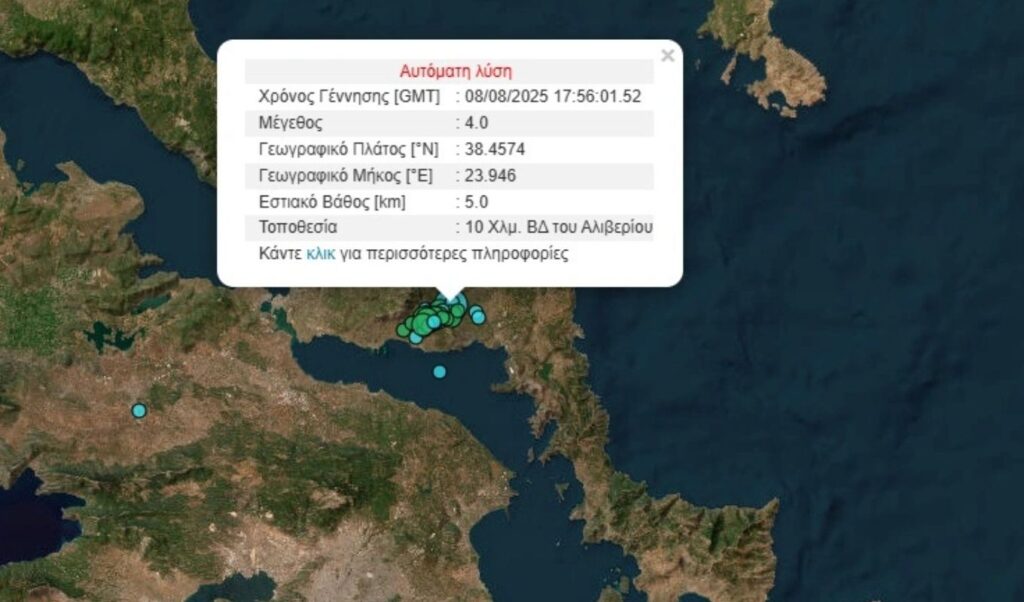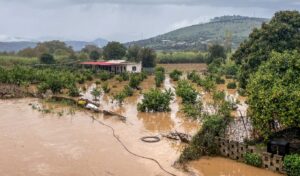A seismic tremor occurred at 20:56 in Euboea, with the earthquake being particularly felt in areas of Attica. According to the preliminary automatic solution from the Athens Geodynamic Institute, the earthquake measured 4.0 on the Richter scale.
The epicenter was located 11 kilometers west of Aliveri. The focal depth was calculated at 5 kilometers.

Attica fault lines: How many Richter points can they produce and how much danger does Athens face?
Athens, Greece’s bustling metropolis, hides a dangerous secret beneath its foundations. It sits atop an extensive network of active fault lines that have been accumulating geological energy for centuries. Seismologists warn that these fault lines in Attica could activate violently, causing catastrophic earthquakes of several Richter points that threaten the capital and surrounding areas.
Read: 4.8 Richter earthquake in Corinthian Gulf: Concern over absence of aftershocks
The main fault lines of Attica
Attica is surrounded by significant seismogenic zones that have caused powerful earthquakes in the past. The five most dangerous and studied fault lines threatening Athens are:
1. Parnitha fault line
Length: Approximately 12 kilometers
History: Last activated in 1999 (5.9 Richter earthquake with 143 fatalities)
Assessment: Remains active with possible reactivation within the 21st century
Risk level: High, due to proximity to densely populated areas such as Ano Liosia, Menidi and Fyli
2. Marathon – Grammatiko fault line
Length: More than 20 kilometers
Characteristics: Located in a geotectonically active area of Attica, near the Eastern Attica fault line
Assessment: Capable of causing earthquakes up to 6.5 Richter
Risk level: Medium to high, affects northern suburbs of Attica
3. Eastern Attica fault line (Koropi – Markopoulo – Lavrio)
Activity: Recorded seismic activity in recent decades in Attica
Assessment: Potential energy up to 6.2 Richter
Risk level: High, due to proximity to the airport and densely populated areas of Attica
4. Submarine Saronic Gulf fault line (Aegina – Methana – Poros)
Geological Zone: Part of the volcanic arc of the South Aegean
Assessment: Capability of generating earthquakes up to 6.7 Richter that would affect Athens
Special Risks: Possibility of creating marine seismic waves (tsunami) in case of submarine mass collapses
5. Atalanti fault line (outside Attica but with influence on Athens)
Distance: About 100 kilometers from Athens, but capable of causing intense vibration in the capital
History: Destroyed cities in 1894 with two earthquakes above 6.5 Richter
Assessment: Capability of causing major earthquakes above 6.7 Richter
Why is Athens so vulnerable to earthquakes?
Professor of seismology Akis Tselentis, has repeatedly emphasized that Athens “has not finished with Enceladus.” The fault lines of Attica, including the Parnitha fault line that was activated in 1999, can reactivate. Modern seismic tomography tools reveal energy accumulation at depths of 5-15 kilometers beneath inhabited areas of Attica.
According to OASP, Attica is the most vulnerable region of Greece due to high population density, even in case of medium-intensity earthquakes. The fault lines of Athens pose a constant threat to the capital.
Athens and the wider Attica region show increased vulnerability to seismic activity for the following reasons:
• Old buildings constructed before the 1985 anti-seismic regulation
• Heterogeneous subsoil with large deposits of alluvial materials that amplify seismic vibrations
• Uncontrolled construction without adequate structural studies in many areas of Attica
• Insufficient maintenance of infrastructure (bridges, roads, old schools) increasing risk from fault lines
• High population concentration in areas near active fault lines of Attica
Protection measures against earthquakes and Attica fault lines
Prevention is the strongest weapon against the threat of fault lines. For the protection of Athens and Attica residents, the following are required:
1. Extensive inspection of structurally vulnerable buildings, especially in areas near active fault lines of Attica
2. Systematic preparedness exercises in schools, public services and municipalities of Athens
3. Update of anti-seismic regulations and intensification of construction controls
4. Installation of digital fault line monitoring systems with new generation sensors
5. Organization of extensive awareness campaigns about fault line risks for citizens, students and elderly
Attica on Enceladus’ clock: Conclusions and prospects
Attica is threatened not only by an isolated fault line, but by an entire system of active tectonic structures that can activate without warning. Scientists, while unable to predict the timing accurately, know with certainty that Athens’ fault lines will activate again in the future.
The challenge for the state and Attica residents is to prepare adequately to reduce the impact of future earthquakes. Systematic monitoring of fault lines, infrastructure reinforcement, and population education are the basic tools for addressing seismic threats in Athens and the wider Attica region.




